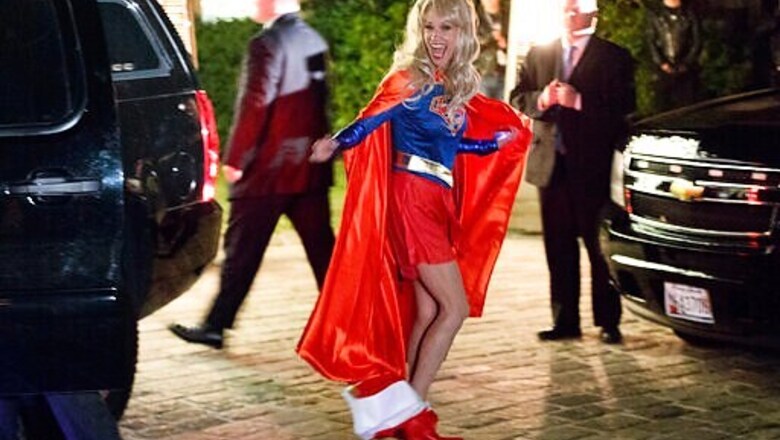
views
New documents from a former Cambridge Analytica insider reveal what an election watchdog group claims was illegal coordination between Donald Trumps 2016 presidential campaign and a billionaire-funded pro-Trump super PAC.
The legal complaint touches on some of the same people involved in todays hotly contested presidential race and provides a detailed account alleging that Trump’s last campaign worked around election rules to coordinate behind the scenes with the political action committee.
The now-defunct British data analytics firm violated election law by ignoring its own written firewall policy, blurring the lines between work created for Trumps 2016 campaign and the Make America Number 1 super PAC, according to an updated complaint the nonpartisan Campaign Legal Center filed Friday with the Federal Election Commission.
The complaint also alleges that Cambridge Analytica which improperly acquired and used 87 million Facebook users profiles to predict their behavior had a shared project calendar for both entities, among other evidence.
The idea that this spending was at all independent is farcical and these emails underscore that, said Brendan Fischer, an attorney for the government oversight group, whose new filing supplements a lawsuit filed four years ago. “Cambridge Analytica not only misused peoples personal data, but it was a conduit for the wealthy family that owned it to unlawfully support the Trump campaign in 2016.
The super PAC created a plethora of crooked Hillary memes that circulated widely on social media, and was financed largely by conservative billionaire Robert Mercer, who also founded, owned and managed Cambridge Analytica. Kellyanne Conway led an earlier incarnation of the PAC when it supported Texas GOP Sen. Ted Cruz before she resigned to advise Trump’s 2016 campaign.
Under federal law, a super PAC may raise and spend unlimited amounts of money, including from corporations and unions, to support candidates for federal office but its illegal for them to coordinate with political campaigns.
The complaint alleges that Cambridge Analytica used information it gained from working with Trumps campaign to develop and target ads for the super PAC supporting his candidacy, constituting unreported in-kind contributions to Donald J. Trump for President, Inc. in the form of coordinated communications.
One September 2016 email it cites is from a Cambridge senior vice president, announcing some of the PAC’s ads against Democratic candidate Hillary Clinton that the Cambridge official says were produced by our production partner Glittering Steel, which then-CEO of the Trump campaign Steve Bannon had a financial stake in.
The White House referred questions to the campaign. Tim Murtaugh, the communications director for Trump’s reelection campaign, did not respond to repeated email and text messages seeking comment.
Kory Langhofer, an attorney for former Cambridge Analytica CEO Alexander Nix, said Nix had no knowledge of what is laid out in the complaint.
“While he was one of the executives there, he claims to be unaware of any coordination,” Langhofer said.
The cache of previously unreleased emails, presentations and slide decks was provided exclusively to The Associated Press by Cambridge Analyticas first business development director, Brittany Kaiser. Last year, Kaiser published a book and starred in a film advocating for data security and regulation of social media.
The documents offer a rare window into how Cambridge collected vast troves of data about likely voters.
Cambridge Analyticas strategy with every new client they had was that the database grew smarter, because it would have more data from the campaigns they ran, Kaiser said. They would erase the data, but they would keep all the learning they derived off the back of it to target people more precisely.
Since resigning from the data-mining firm and taking her computer with her, Kaiser has met with former special counsel Robert Muellers office and an associate of Julian Assange. Kaiser has also founded a nonprofit group for children’s digital education and is managing the presidential campaign of independent candidate Brock Pierce, a former child actor and cryptocurrency entrepreneur.
Some officials, like Conway and former Cambridge vice president Bannon, went on to play senior roles in the administration. Other people whose names appear in the emails have worked for organizations supporting Trumps reelection bid.
They include Matt Oczkowski, Cambridges ex-head of product whose company HuMn Behavior has been paid at least $180,000 by the Trump 2020 campaign, and Brad Parscale, the 2016 campaigns digital director who until July managed Trumps reelection campaign.
Conway told AP she was not aware of any alleged coordination, and said the people at the tippy top of Cambridge were “crooks and thieves and liars.
You are looking at a bunch of C.Y.A. emails where they are pretending that they are somehow responsible for something positive, and that has nothing to do with me, she said. Its men behaving badly.
A spokeswoman for Bannon did not offer comment. Oczkowski did not respond to a message sent to his company or LinkedIn account.
Cambridge dissolved after facing investigations for playing a key role in the 2014 breach of Facebook users personal data. The company denied it used the data in Trumps 2016 campaign, an assertion which ex-employees have disputed, although Facebook CEO Mark Zuckerberg has said the data could have been used in Russian propaganda efforts.
Mercer has largely stepped back from Trumps campaign this year, although in February he donated $355,200 to a Trump fundraising committee. In 2016, the family poured millions into pro-Trump groups.
Mercer first supported a Conway-led super PAC backing Cruz for president. When Cruz dropped out, the Mercers threw their support to Trump and the political action committee became Make America Number 1.
Oczkowski, who Kaiser said she trained, joined Cambridges parent company in late 2015, according to the documents.
In one email, Oczkowski briefed colleagues on his efforts to win business from the National Rifle Association to work on its Trigger the Vote campaign with Washington-based PR firm The Herald Group.
Documents show projects related to Trigger The Vote appear to have netted Cambridge work valued at $855,000 by early 2017. There are few details about the work, but Kaiser, who was involved in the negotiations, said Cambridge ingested data from the NRA and the National Shooting Sports Foundation into its system to build models that helped Republican candidates predict what would succeed with gun owners.
Each year, they run a large campaign aimed at voter education, Oczkowski wrote about the foundation in February 2016. They call it voter education to avoid the corporate proxy tax by directly endorsing any candidates.
The foundation and PR firm did not respond to requests for comment. NRA spokeswoman Amy Hunter confirmed the PR firm worked on Trigger the Vote, but said “the NRA had limited interaction with the organizations and declined to specify how the data was used.
In all, Cambridge ran over 4,000 ad campaigns for the Trump campaign that generated more than 1.4 billion impressions, with persuasion ads leading to a 3 percent increase in average favorability and get-out-the-vote ads yielding a 2 percent increase in people voting absentee, according to a post-election presentation.
The same presentation identified some voters as ripe for deterrence. Last week, however, the United Kingdoms Information Commissioner called Cambridges predictive analytics exaggerated and ineffective.
In another document, Make America Number 1 took credit for Trump’s surprise win in Michigan.
We did work other groups and individuals were unwilling to do in defeating Hillary Clinton, the presentation reads. Looking forward to the 2018 and 2020 elections, MAN1 still serves a purpose by collecting and refining data for use advancing policy and directly advocating for or against candidates.
While Cambridge assured Facebook that the data they held was deleted, Kaiser wonders who controls the models they built, and how they are being used today.
The idea was that all that data would help any of the Republican candidates they were campaigning for, she said. Now the question is, what happened to that data?
Disclaimer: This post has been auto-published from an agency feed without any modifications to the text and has not been reviewed by an editor
Read all the Latest News and Breaking News here




















Comments
0 comment